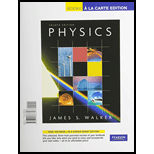
Concept explainers
(a)
Interpretation:
The balanced equation for the following nuclear reaction should be written.
The bombardment of Fe-54 with alpha particle results in the production of another nucleus with two protons.
Concept introduction:
A reaction in which a nucleus of an atom or two nuclei and a subatomic particle collide to form one or more nuclide which is different from the starting nuclide is known as nuclear reaction. Nuclear reactions can be classified as nuclear fission and nuclear fusion.
Answer to Problem 18QAP
Explanation of Solution
The reaction in which the change in
Given that, the bombardment of Fe-54 with alpha particle results in the production of another nucleus with two protons.
Fe-54 is the isotope of iron, atomic number of iron is 26.
To identify the missing species: Let the species be
The reaction can be written as:
To balance the reaction: Mass number of the reactant must be equal to the mass number of the product.
Now, atomic number or charges must be balanced, therefore:
Thus, the product must have mass number and atomic number equal to 56 and 26. From the periodic table, the nucleus is
Overall reaction is:
(b)
Interpretation:
The balanced equation for the following nuclear reaction should be written.
The bombardment of Mo-96 with
Concept introduction:
A reaction in which a nucleus of an atom or two nuclei and a subatomic particle collide to form one or more nuclide which is different from the starting nuclide is known as nuclear reaction. Nuclear reactions can be classified as nuclear fission and nuclear fusion.
Answer to Problem 18QAP
Explanation of Solution
The reaction in which the change in atomic numbers, energy states and mass number of nuclei takes place is known as nuclear reaction.
Given that, the bombardment of Mo-96 with
Mo-96 is the isotope of molybdenum, atomic number of molybdenum is 42.
Now, symbol of neutron is
To identify the missing species: Let the species be
The reaction can be written as:
To balance the reaction: Mass number of the reactant must be equal to the mass number of the product.
Now, atomic number or charges must be balanced, therefore:
Thus, the product must have mass number and atomic number equal to 97 and 43. From the periodic table, the nucleus is
Overall reaction is:
(c)
Interpretation:
The balanced equation for the following nuclear reaction should be written.
The bombardment of Ar-40 with an unknown particle in the production of K-43 with a proton.
Concept introduction:
A reaction in which a nucleus of an atom or two nuclei and a subatomic particle collide to form one or more nuclide which is different from the starting nuclide is known as nuclear reaction. Nuclear reactions can be classified as nuclear fission and nuclear fusion.
Answer to Problem 18QAP
Explanation of Solution
The reaction in which the change in atomic numbers, energy states and mass number of nuclei takes place is known as nuclear reaction.
Given that, the bombardment of Ar-40 with an unknown particle in the production of K-43 with a proton.
Ar-40 is the isotope of argon atomic number of argon is 18.
K-43 is the isotope of potassium, atomic number of potassium is 19.
To identify the missing species: Let the species be
The reaction can be written as:
To balance the reaction: Mass number of the reactant must be equal to the mass number of the product.
Now, atomic number or charges must be balanced, therefore:
Thus, the reactant must have mass number and atomic number equal to 4 and 2. From the periodic table, the nucleus is
Overall reaction is:
(d)
Interpretation:
The balanced equation for the following nuclear reaction should be written.
The bombardment of nucleus with a neutron results in the production of a proton with P-31.
Concept introduction:
A reaction in which a nucleus of an atom or two nuclei and a subatomic particle collide to form one or more nuclide which is different from the starting nuclide is known as nuclear reaction. Nuclear reactions can be classified as nuclear fission and nuclear fusion.
Answer to Problem 18QAP
Explanation of Solution
The reaction in which the change in atomic numbers, energy states and mass number of nuclei takes place is known as nuclear reaction.
Given that, the bombardment of nucleus with a neutron results in the production of a proton with P-31.
P-31 is the isotope of phosphorus, atomic number of phosphorus is 15.
To identify the missing species: Let the species be
The reaction can be written as:
To balance the reaction: Mass number of the reactant must be equal to the mass number of the product.
Now, atomic number or charges must be balanced, therefore:
Thus, the product must have mass number and atomic number equal to 13 and 16. From the periodic table, the nucleus is
Overall reaction is:
Want to see more full solutions like this?
Chapter 18 Solutions
Student Solutions Manual For Masterton/hurley's Chemistry: Principles And Reactions, 8th
 Chemistry: Principles and ReactionsChemistryISBN:9781305079373Author:William L. Masterton, Cecile N. HurleyPublisher:Cengage LearningChemistry: Matter and ChangeChemistryISBN:9780078746376Author:Dinah Zike, Laurel Dingrando, Nicholas Hainen, Cheryl WistromPublisher:Glencoe/McGraw-Hill School Pub Co
Chemistry: Principles and ReactionsChemistryISBN:9781305079373Author:William L. Masterton, Cecile N. HurleyPublisher:Cengage LearningChemistry: Matter and ChangeChemistryISBN:9780078746376Author:Dinah Zike, Laurel Dingrando, Nicholas Hainen, Cheryl WistromPublisher:Glencoe/McGraw-Hill School Pub Co Chemistry: The Molecular ScienceChemistryISBN:9781285199047Author:John W. Moore, Conrad L. StanitskiPublisher:Cengage Learning
Chemistry: The Molecular ScienceChemistryISBN:9781285199047Author:John W. Moore, Conrad L. StanitskiPublisher:Cengage Learning Living By Chemistry: First Edition TextbookChemistryISBN:9781559539418Author:Angelica StacyPublisher:MAC HIGHER
Living By Chemistry: First Edition TextbookChemistryISBN:9781559539418Author:Angelica StacyPublisher:MAC HIGHER Chemistry & Chemical ReactivityChemistryISBN:9781133949640Author:John C. Kotz, Paul M. Treichel, John Townsend, David TreichelPublisher:Cengage Learning
Chemistry & Chemical ReactivityChemistryISBN:9781133949640Author:John C. Kotz, Paul M. Treichel, John Townsend, David TreichelPublisher:Cengage Learning Chemistry & Chemical ReactivityChemistryISBN:9781337399074Author:John C. Kotz, Paul M. Treichel, John Townsend, David TreichelPublisher:Cengage Learning
Chemistry & Chemical ReactivityChemistryISBN:9781337399074Author:John C. Kotz, Paul M. Treichel, John Townsend, David TreichelPublisher:Cengage Learning





